|
Advantech TREK-775
Premium class rugged vehicle mount PC
(review by Conrad H. Blickenstorfer -- photography by Carol Cotton)
The TREK-775 is an industrial vehicle mounted computer made by Advantech, the seasoned Taiwanese embedded and industrial computing maker that is seeking to expand its position in the US and other markets. Founded more than 25 years ago by three ex-Hewlett Packard engineers, Advantech provides a wide variety of computing platforms, web-based technologies, and customization services in embedded & industrial computing, eServices & applied computing, and industrial automation. Advantech has over 3,000 employees and a growing international sales, marketing and support network. The company sells either directly or works with third parties to provide complete computing solutions for various industries, including medical computing, industrial Tablet PCs, panels, rugged handhelds, and vehicle mounted computers like the TREK-775 featured here.

Design goals for a vehicle mount like the TREK-775
The Advantech TREK-775 is a computer created to be used in vehicles ranging from forklifts to trucks to tanks. It is not a mobile computer that you carry around and then insert into a vehicle cradle; it is designed to be mounted inside a vehicle and be used there. Its intended application is in warehouses, docks, container yards and even freezers. Since the vehicles the TREK-775 will be used in may operate in harsh environmental conditions, the TREK is a rugged device that can handle extreme conditions. It's also a premium device with a fanless cast aluminum enclosure and sporting an elegant industrial design.
Computers like the TREK-775 are primarily used to run custom applications for specific tasks. While they can support limited functionality as general purpose computers (and you can run standard Windows XP on the TREK-775), these machines generally use embedded operating systems such as Windows XP Embedded and Windows CE, and the TREK-775 is no exception. This means that the machine has very modest hardware requirements and generates very little heat. The TREK-775 is able to get by with a 600MHz Intel Celeron M or, if full Windows XP is required, a 1.1GHz Pentium M processor.
Machines like the TREK-775 also do not need the very latest in chipsets, special features and connectivity options. So do not expect integrated vidcams, superhigh resolution or advanced audio. Instead, everything is engineered for the job at hand. Operation must be as simple as possible so as not to distract. Controls must be large and handy. Interfaces must be easily accessible and support whatever peripherals customers in the field are likely to have a need for. However, despite all that, the machine must also be able to handle the latest technologies. Not an easy task at all. How did Advantech go about it?
The use of embedded operating systems: Windows XP Embedded and Windows CE 5.0
The key to understanding computers like the TREK-775 and what they offer is in understanding the difference between a general purpose operating system and an embedded operating system.
General purpose operating systems such as Windows XP or Windows Vista are just that, designed for general purpose computing. You can run anything you want on it and so Microsoft equipped Windows XP and Vista with all the drivers and software and utilities users could possibly need. As a result, they are large operating system with numerous processes and services running all the time, all consuming prodigious amounts of memory and power.
Embedded (also known as "componentized") operating systems are totally different. The central idea of an embedded OS is to only include what is needed to perform a limited set of tasks and leave everything else behind. This dramatically reduces the size of the operating system and equally dramatically reduces hardware requirements. Windows XP Embedded is generally used for smart, connected and service-oriented commercial and consumer devices that do not need all of Windows XP, yet can still run thousands of existing Windows applications.
Embedded operating systems are not one-size-fits all. A manufacturer and service provider like Advantech will determine what a system is for and what tasks it should be able to perform. They then include just those components they need (there are over 10,000 available) to create a lean embedded OS platform that doesn't take much space or resources but still does sophisticated tasks like multimedia, browsing, communications or whatever an application requires. Essentially you get the power of Windows XP, but without any unneeded overhead.
Don't ever make the mistake of using conventional benchmarks to select an embedded systems machine. Benchmarks measure raw power, but not how efficiently that power is put to use. A machine like our review TREK-775 with its 600 MHz Celeron M processor and 256MB of RAM is hardly a benchmark queen, but it's quick and responsive at what it does, and that is the whole point of an embedded system computer.
So why does Advantech also offer Windows CE 5.0? Unlike XP Embedded, Windows CE only supports a subset of the full Windows API but it is a supremely compact and efficient scalable operating system with plenty of programming support. And since Windows CE's multi-threaded, multi-tasking, fully preemptive OS environment was designed from the start for hardware with extremely limited resources, Windows CE has become the OS of choice for many streamlined field applications and is able to create a CE image for just about any application, making the creation of customized software even simpler.
To provide an idea of the resources needed, a Windows CE-based TREK-775 requires just 128MB of RAM and 128MB of Flash to provide speedy performance on a 600MHz Celeron M processor. An XP Embedded version may use the same 600MHz Celeron M on either 4GB of Flash or a 40GB hard disk. A machine running the full version of Windows XP will likely come with the 1.1GHz Pentium M processor and a 40GB hard disk.
Enhanced Write Filter
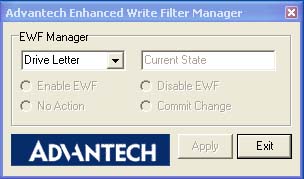 The TREK-775 comes with a utility called the Enhanced Write Filter, or EWF. This is an interesting feature supported by the XP Embedded operating system. The TREK-775 comes with a utility called the Enhanced Write Filter, or EWF. This is an interesting feature supported by the XP Embedded operating system.
EWF redirects write operations to another storage location and totally write-protects the run-time image, thus preventing any damage that might be caused by an unexpected power failure, vibration or even a virus attack.
To learn more about this particular feature of XP Embedded, read the Enhanced Write Filter section on the Microsoft Embedded Developer Center.)
That said, let's take a look at this interesting machine.
Uncompromising design
While mobile computers are carried around and therefore must be light and handy, the design requirements for a vehicle mounted computer are very different. Ruggedness, reliability, utility and ease of use are the primary goals. To that extent, Advantech's engineers and designers created a fanless aluminum enclosure with integrated fins for cooling and 12 industry-standard mounting holes. The TREK-775 measures 12.2 x 9.9 x 2.9 inches and weighs 8.8 pounds. The housing is rock-solid and is painted matte black. The image below shows the front and all four sides of the TREK-775.

The TREK-775's display is a Mitsubishi TFT LCD measuring 10.4 inches diagonally. It has 800 x 600 pixel SVGA resolution and can display 256k colors. Horizontal viewing angle is an excellent 140 degrees. The vertical viewing angle is 110 degrees, which is still sufficient in a vehicle mount. Advantech rates the LCD's mean time between failure at 50,000 hours. If the display were on 24 hours per day every day, that'd still be 5.7 years. The backlight is rated to have the same lifespan. Unlike Tablet PCs that often have a variety of hardware controls along the edge of the display, the TREK-775 has just one. You can increase and decrease screen brightness via two large integrated buttons.
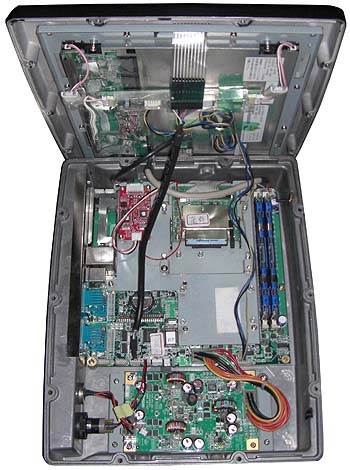 As stated above, the engine compartment contains components that, while several generations removed from Intel's state-of-the-art, are tried-and-true, universally supported, and totally reliable. Our machine came with a 600 MHz ULV Celeron M with 512KB of L2 cache on its PCM-9689 motherboard. Also available is a 1.1GHz LV Pentium M chip. Both models use a Award Flash BIOS that's ACPI 2.0 compliant and run a 400 MHz frontside bus. Our machine managed to run Embedded XP quickly and effortlessly on just 256MB of RAM and a 4GB 233X RiDATA Compact Flash card.
As stated above, the engine compartment contains components that, while several generations removed from Intel's state-of-the-art, are tried-and-true, universally supported, and totally reliable. Our machine came with a 600 MHz ULV Celeron M with 512KB of L2 cache on its PCM-9689 motherboard. Also available is a 1.1GHz LV Pentium M chip. Both models use a Award Flash BIOS that's ACPI 2.0 compliant and run a 400 MHz frontside bus. Our machine managed to run Embedded XP quickly and effortlessly on just 256MB of RAM and a 4GB 233X RiDATA Compact Flash card.
We actually ran performance benchmarks both with 256MB of RAM and with a full gigabyte. The difference was less than two percent. This highly efficient machine simply does not need more RAM with the embedded OS, and putting more in does not improve performance (though playing with paging file size in the Windows Systems Properties> Advanced> Performance Settings> Advanced> Virtual Memory panel may make a difference).
Despite the IP65 sealing, the TREK-775 can be easily opened by undoing nine Philips screws. This provides ready access for field maintenance, upgrades, and component switches or repair. However, do make certain that the rubber O-ring seal is present and properly in place when the unit is closed again. Else there will be no good seal.
In the picture to the right you can see how the TREK-775 provides easy access to all components. There is plenty of room, too. All rugged systems should be so easily expandable and easy to work on.
Touch panel
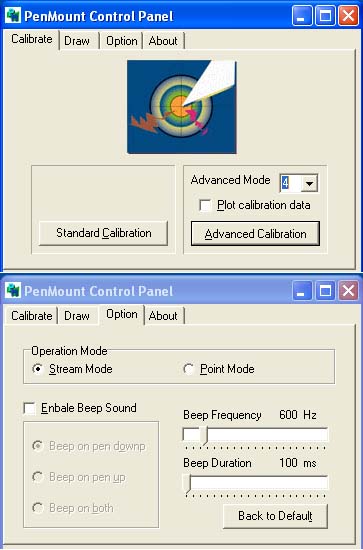 The Advantech TREK-775 uses an analog resistive touchscreen with a USB interface and AMT as well as Dynapro/3M MicroTouch technology. It is a heavy-duty unit that is rated at over ten million depressions. The resistive touch screen can be operated either with any stylus or with a finger. It is fairly smudge-resistant -- a small thing, but a quality that comes in handy. The Advantech TREK-775 uses an analog resistive touchscreen with a USB interface and AMT as well as Dynapro/3M MicroTouch technology. It is a heavy-duty unit that is rated at over ten million depressions. The resistive touch screen can be operated either with any stylus or with a finger. It is fairly smudge-resistant -- a small thing, but a quality that comes in handy.
According to Advantech, the impact-resistant, scratch-resistant touchscreen offers 80% light transmission. There's antiglare treatment as well, making the TREK-775 more pleasant to use in varying lighting conditions.
The unit comes with a PenMount Control Panel that let's you calibrate the touchscreen using 4, 9, 16, or 25 points, with 25 points offering maximum accuracy. A "Draw" mode provides digitizer statistics and can be used for debugging. An option menu lets you set the operation mode either to stream mode or point mode.
In the panel's option menu you can also enable a beep sound to occur on pen down or pen up (or both), and even set its frequency and duration. This may sound strange, but in noisy vehicle operation, having auditory feedback to confirm a touch operation may come in handy.
Compared to some of the other rugged Advantech machines we've seen, the TREK's touchscreen does not have the elaborate edge compensation controls that allow you to precisely define edge compensation for all four sides, i.e., set it so the cursor thinks the edge is either farther away or closer in. No big deal, but it may come in handy.
Power
The TREK-775 does not have a battery and runs on vehicle power instead. The vehicles in which a TREK-775 computer is usually installed run on 12, 34 or 48 Volt DC power, and the TREK can handle anything between six and 58 Volts.
Vehicle mounted computers without a main battery can be wired into the vehicle's electricity in various ways. You would not, for example, want for the computer to continue drawing power when the vehicle has been shut down or else you'd deplete the vehicle battery. You also do not want for the computer to be abruptly shut down when the ignition is turned off. The answer is a power off delay which keeps the machine running for 30 seconds once the ignition has been turned off. The computer uses that time to shut down gracefully. Likewise, there are fail-saves that shut down the computer when vehicle voltage drops below a certain level and automatically reboots the system when the voltage once again exceeds a pre-set threshold.
The TREK can also be either linked to the ignition switch or use its own on-off switch. All those power settings are determined via motherboard jumpers. The power cord carries six leads that facilitate not only the common negative and positive voltages, but also ground and vehicle ignition.
Wireless and expansion
The Advantech TREK-775 can be equipped with a 802.11a/b/g mini-PCI WiFi module that can either be controlled by the standard Windows Zero Configuration utility or also via the substantially more comprehensive and well-documented Advantech/RaLink Intelligent Wireless Utility. 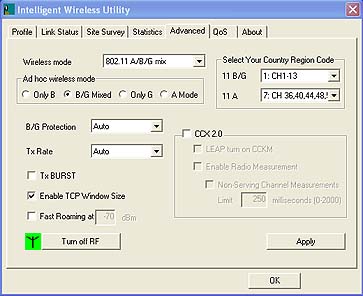 The Intelligent Wireless Utility is a tool for advanced users who want to have precise control over their wireless setup. The Intelligent Wireless Utility is a tool for advanced users who want to have precise control over their wireless setup.
- Link Status shows speed, link quality, signal strength and noise level.
- Site Survey shows all networks in the vicinity with all their characteristics
- Statistics can be used to detect network problems
- Advanced can be used to set the WiFi mode, channels, country codes and various parameters
- A special WMM panel controls wireless multimedia.
If you want to stay with the standard Microsoft setup, the Intelligent Wireless Utility can still provide a variety of monitoring functions without interfering with the Windows Zero configuration or profiles.
In order to provide exceptional reception, the TREK-775 has a gold-plated connector for an external antenna.
An optional module adapter board with SIM card slot can include both GPS and GSM/GPRS modules. The housing accommodates an external antenna.
Bluetooth is not specifically listed, but I assume it can be made available via expansion board or module.
Interface and connectivity
Internally, the TREK-755 has an IDE interface for the hard disk (Ultra DMA 33/66/100) and a 50-pin socket that supports a solid state disk via CompactFlash. A mini-PCI bus expansion slot accepts a Type III mini PCI card.
The TREK=775 supports both serial and USB connection. There are two USB 2.0 jacks and no less than four 9-pin DB25 connectors. Two of them are standard RS232, the other two support US232/422/485. The reason for the four serial ports is that many peripherals used in the field still use this type of interface, and not USB. There are also two PS/2 ports, one for a keyboard and one for a mouse. An RJ45 jacks provides wired 10/100-BaseT Ethernet local area network connectivity. There are two PC Card Type II slots. The power switch carries the same IP65 rating as the front and sides of the housing. It has a screw-lock so that it cannot come loose.
The graphics subsystem uses the Intel 855GME chipset that uses system memory for variable size frame buffers (up to 64MB).
Ruggedness
In terms of ruggedness, the aluminum enclosure without any ventilation holes or other ports provides IP65 sealing and is NEMA4 compliant. However, things are different in a vehicle mount; the IP65 rating applies to every surface of the TREK-775 except for the bottom with its bank of exposed connectors. If not in use, the connector banks could very easily be sealed and there are, in fact, predrilled screw holes.
Standard operating temperature is 32 to 104 degrees Fahrenheit for hard disk-based units. Industrial grade hard disks designed for wider temperature ranges can be used as well, and they will extend the operating temperature range. Compact Flash-based models have an extremely wide operating temperature range of -4 to 140 degrees Fahrenheit.
Vehicle-mount units must be able to absorb significant shock and vibration. The TREK-775 can handle 30G peak acceleration shock (11 millisecond test pulse) operating, as well as 1G RMS random vibration from 5 to 500 Hertz for hard disk models and 3G for Flash-based models (tested for one hour in all three axis). The machine has even be tested on how it survives extreme handling during shipping in its box, and whether it survives a 3-foot drop in its box on each corner. The picture below shows one of the vibration tests.
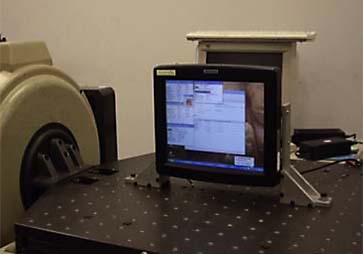 A ruggedness testing report shows an Advantech TREK-776 (almost the same unit, 12.1-inch display) was subjected to a 24-hour dry heat testing at 113 degrees Fahrenheit and a high temperature 24-hour test at 150 degrees, both of which the machine passed. It also passed a 24-hour low temperature test at 23 degrees with a hard disk model and a 24-hour test at -13 degrees Fahrenheit with a CF Card model. These were all operating mode test using Passmark Burn-In v4.0 on XP Embedded. A ruggedness testing report shows an Advantech TREK-776 (almost the same unit, 12.1-inch display) was subjected to a 24-hour dry heat testing at 113 degrees Fahrenheit and a high temperature 24-hour test at 150 degrees, both of which the machine passed. It also passed a 24-hour low temperature test at 23 degrees with a hard disk model and a 24-hour test at -13 degrees Fahrenheit with a CF Card model. These were all operating mode test using Passmark Burn-In v4.0 on XP Embedded.
The machine further passed a 24-hour storage test at 140 degree and 95% humidity, and a low temperature storage test at -40 degrees Fahrenheit. Next came a 104 degree, 95% humidity 48-hour damp heat test, and then a "four corner" test where the machine cycled between 23 and 113 degrees Fahrenheit, both at its lowest and highest operating voltage. They also turned the power on and off 1,000 times at extreme temperatures, cold-started the machine at 14 and -13 degrees (HD and CF) numerous times. Clearly, this is a machine that keeps working in extreme environmental conditions.
Advantech further lists a variety of standards that the unit meets. Among them are EMC, EMS, Safety and RF certifications that apply to various markets. If an intended application has specific environmental requirements, check with Advantech.
Vehicle mounting solutions
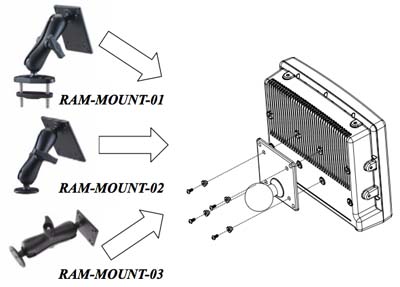 Vehicle computers like the TREK-775 may encounter a variety of different mounting requirements, and therefore a need for different mounting kits and modules. Advantech offers a "universal arm" that uses the mounting holes on the side of the unit. Vehicle computers like the TREK-775 may encounter a variety of different mounting requirements, and therefore a need for different mounting kits and modules. Advantech offers a "universal arm" that uses the mounting holes on the side of the unit.
Advantech also offers three different types of RAM-MOUNT kits from National Products. National Products' patented RAM-MOUNT solutions are the undisputed industry leader with their unique rubber ball and connector arm system that makes for unparalleled flexibility and near total absence of vibration.
To change the viewing angle, you simply loosen the large, grippy control knob, get the unit into the proper position, and tighten it. Mounting plates are all industry standard.
Bottom line
The Advantech TREK-775 is a premium quality ruggedized industrial vehicle mount computer from an experienced Taiwanese embedded and industrial systems company with a worldwide presence. Its heavy, solid matte-black aluminum housing feels invulnerable and has been tested for operation in temperature extremes and heavy shock and vibration.
The TREK-775 is internally configured either as an embedded device running Windows XP Embedded on a 4GB solid state disk or as a full Windows XP machine using a hard disk. Should the application demand it, Advantech can also configure the machine to run Windows CE 5.0. 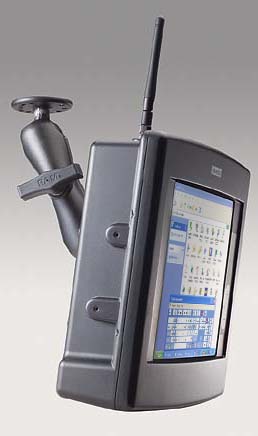 Our review unit provided impressive performance even from minimal hardware (a 600 MHz Intel Celeron M processor and 256MB of RAM). The unit does not need a fan, runs silently, and barely warms up. The aluminum body is sealed to IP65 specifications and can take a lot of abuse. Our review unit provided impressive performance even from minimal hardware (a 600 MHz Intel Celeron M processor and 256MB of RAM). The unit does not need a fan, runs silently, and barely warms up. The aluminum body is sealed to IP65 specifications and can take a lot of abuse.
In vehicles, the optimal display size varies and so Advantech offers both the TREK-775 with a 10.4-inch display as well as a slightly larger model, the TREK-776, that has a 12.1-inch screen. The resistive touch screen is very responsive thanks to a USB interface, and it is also highly configurable for optimal use with both a stylus or fingers. It also has much appreciated antiglare treatment.
The TREK-775 offers good onboard connectivity for use with a variety of current or legacy devices and peripherals. You get two USB 2.0 USB ports, two RS232 serial ports, another two that support RS232/422/485, two PS/2 ports for mouse and keyboard should you need them, and LAN. There are also two PC Card slots, plus plenty of room inside the unit for further customization. You can get 802.11a/b/g WiFi with external antenna, GPS also with external antenna, as well as GSM/GPRS wireless wide area networking.
In the storage department, you can populate two slots with up to 2GB of RAM, although our XP Embedded unit worked as well on just 256MB of RAM as it did in tests with a full gigabyte.
The TREK-775 is a clean machine that combines no-nonsense industrial design, superb ruggedness, easy customization and maintenance, and surprisingly quick performance. It can be configured for a large variety of applications in all kinds of vehicular applications.
-- Conrad H. Blickenstorfer
Advantech TREK-775 Specs:
| Type |
Rugged vehicle-mounted tablet computer
|
| OS |
Windows XP, Windows XP Embedded, Windows CE 5.0
|
| Processor |
Ultra low voltage 600MHz Intel Celeron M or low voltage 1.1GHz Pentium M
|
| Display Chipset |
Intel 855GME and ICH4-M
|
| Memory |
Up to 2GB DDR 333 SDRAM in two 184-pin sockets |
| Display |
10.4" SVGA (800 x 600) color TFT with 140/110 degrees viewing angle and 400 nit backlight (5-100% brightness control in 12 steps)
|
| Digitizer |
Resistive impact and scratch resistant touch screen with USB interface, antiglare treatment, and 80% light transmission |
| Keyboard |
Optional external USB |
| Storage |
Supports IDE-based 2.5-inch HDD or CF-based Flash
|
| Expansion slots |
1 Mini-PCI Type III A/B, 2 PC Card Type II (or 1 Type III)
|
| Housing |
Die-cast aluminum with VESA-standard RAM mounting |
| Size (inches) |
12.2 x 9.9 x 2.9 |
| Weight |
8.8 lbs.
|
| Operating temperature |
-4 to 140 degree Fahrenheit with SSD, 32 to 104 for hard disk based units |
| Ingress protection |
IP65 (front bezel, back cover and sides) |
| Shock |
30G peak acceleration (11 ms duration) |
| Vibration |
1G (operating with HDD); 3G (operating with CF card) |
| EMC |
CCC, CE, FCC Class B |
| Safety |
CCC, UL, CUL, CE |
| Humidity |
10-95% at 104 degrees Fahrenheit, non-condensing |
| Power |
9-58 Volt DC vehicle power |
| Interface |
2 USB 2.0, 2 RS-232/422/485, 2 RS-232, RJ45 LAN (10/100), 2 PS/2 |
| Wireless options |
Flexible expansion capability for MiniPCI 802.11b/g WiFi, GPS, GSM/GPRS
|
| Price |
depends on configuration |
| Contact |
Advantech www.advantech.com.tw |
(copyright 2008 RuggedPCReview.com)
Advantech Corporation
38 Tesla, Suite 100
Irvine, CA 92618
Toll Free: 1-800-866-6008
Ph: 949-789-7178
Fax: 949-789-7179
ECGInfo@advantech.com
www.advantech.com
Advantech Co. Ltd.
No.1, Alley 20, Lane 26, Rueiguang Road
Neihu District, Taipei Taiwan 114, R.O.C.
Tel: 886-2-2792-7818
Fax: 886-2-2794-7301
www.advantech.com
|


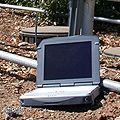


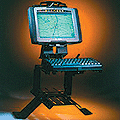






 The TREK-775 comes with a utility called the Enhanced Write Filter, or EWF. This is an interesting feature supported by the XP Embedded operating system.
The TREK-775 comes with a utility called the Enhanced Write Filter, or EWF. This is an interesting feature supported by the XP Embedded operating system.

 As stated above, the engine compartment contains components that, while several generations removed from Intel's state-of-the-art, are tried-and-true, universally supported, and totally reliable. Our machine came with a 600 MHz ULV Celeron M with 512KB of L2 cache on its PCM-9689 motherboard. Also available is a 1.1GHz LV Pentium M chip. Both models use a Award Flash BIOS that's ACPI 2.0 compliant and run a 400 MHz frontside bus. Our machine managed to run Embedded XP quickly and effortlessly on just 256MB of RAM and a 4GB 233X RiDATA Compact Flash card.
As stated above, the engine compartment contains components that, while several generations removed from Intel's state-of-the-art, are tried-and-true, universally supported, and totally reliable. Our machine came with a 600 MHz ULV Celeron M with 512KB of L2 cache on its PCM-9689 motherboard. Also available is a 1.1GHz LV Pentium M chip. Both models use a Award Flash BIOS that's ACPI 2.0 compliant and run a 400 MHz frontside bus. Our machine managed to run Embedded XP quickly and effortlessly on just 256MB of RAM and a 4GB 233X RiDATA Compact Flash card.
 The Advantech TREK-775 uses an analog resistive touchscreen with a USB interface and AMT as well as Dynapro/3M MicroTouch technology. It is a heavy-duty unit that is rated at over ten million depressions. The resistive touch screen can be operated either with any stylus or with a finger. It is fairly smudge-resistant -- a small thing, but a quality that comes in handy.
The Advantech TREK-775 uses an analog resistive touchscreen with a USB interface and AMT as well as Dynapro/3M MicroTouch technology. It is a heavy-duty unit that is rated at over ten million depressions. The resistive touch screen can be operated either with any stylus or with a finger. It is fairly smudge-resistant -- a small thing, but a quality that comes in handy.
 The Intelligent Wireless Utility is a tool for advanced users who want to have precise control over their wireless setup.
The Intelligent Wireless Utility is a tool for advanced users who want to have precise control over their wireless setup.
 A ruggedness testing report shows an Advantech TREK-776 (almost the same unit, 12.1-inch display) was subjected to a 24-hour dry heat testing at 113 degrees Fahrenheit and a high temperature 24-hour test at 150 degrees, both of which the machine passed. It also passed a 24-hour low temperature test at 23 degrees with a hard disk model and a 24-hour test at -13 degrees Fahrenheit with a CF Card model. These were all operating mode test using Passmark Burn-In v4.0 on XP Embedded.
A ruggedness testing report shows an Advantech TREK-776 (almost the same unit, 12.1-inch display) was subjected to a 24-hour dry heat testing at 113 degrees Fahrenheit and a high temperature 24-hour test at 150 degrees, both of which the machine passed. It also passed a 24-hour low temperature test at 23 degrees with a hard disk model and a 24-hour test at -13 degrees Fahrenheit with a CF Card model. These were all operating mode test using Passmark Burn-In v4.0 on XP Embedded.
 Vehicle computers like the TREK-775 may encounter a variety of different mounting requirements, and therefore a need for different mounting kits and modules. Advantech offers a "universal arm" that uses the mounting holes on the side of the unit.
Vehicle computers like the TREK-775 may encounter a variety of different mounting requirements, and therefore a need for different mounting kits and modules. Advantech offers a "universal arm" that uses the mounting holes on the side of the unit.
 Our review unit provided impressive performance even from minimal hardware (a 600 MHz Intel Celeron M processor and 256MB of RAM). The unit does not need a fan, runs silently, and barely warms up. The aluminum body is sealed to IP65 specifications and can take a lot of abuse.
Our review unit provided impressive performance even from minimal hardware (a 600 MHz Intel Celeron M processor and 256MB of RAM). The unit does not need a fan, runs silently, and barely warms up. The aluminum body is sealed to IP65 specifications and can take a lot of abuse.